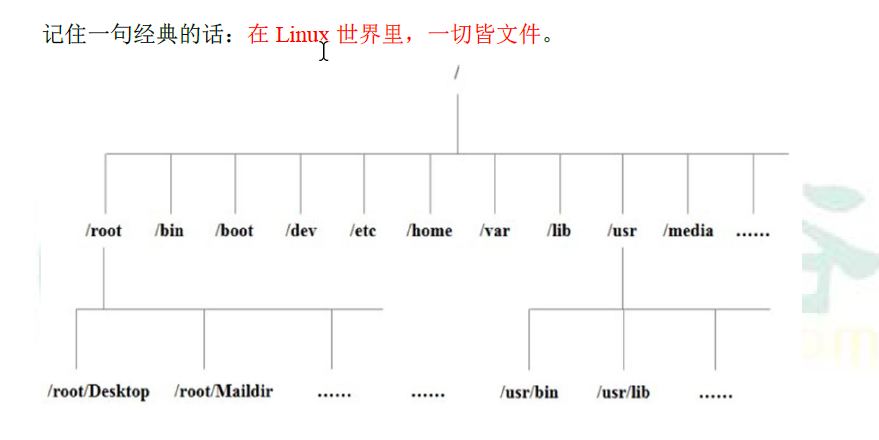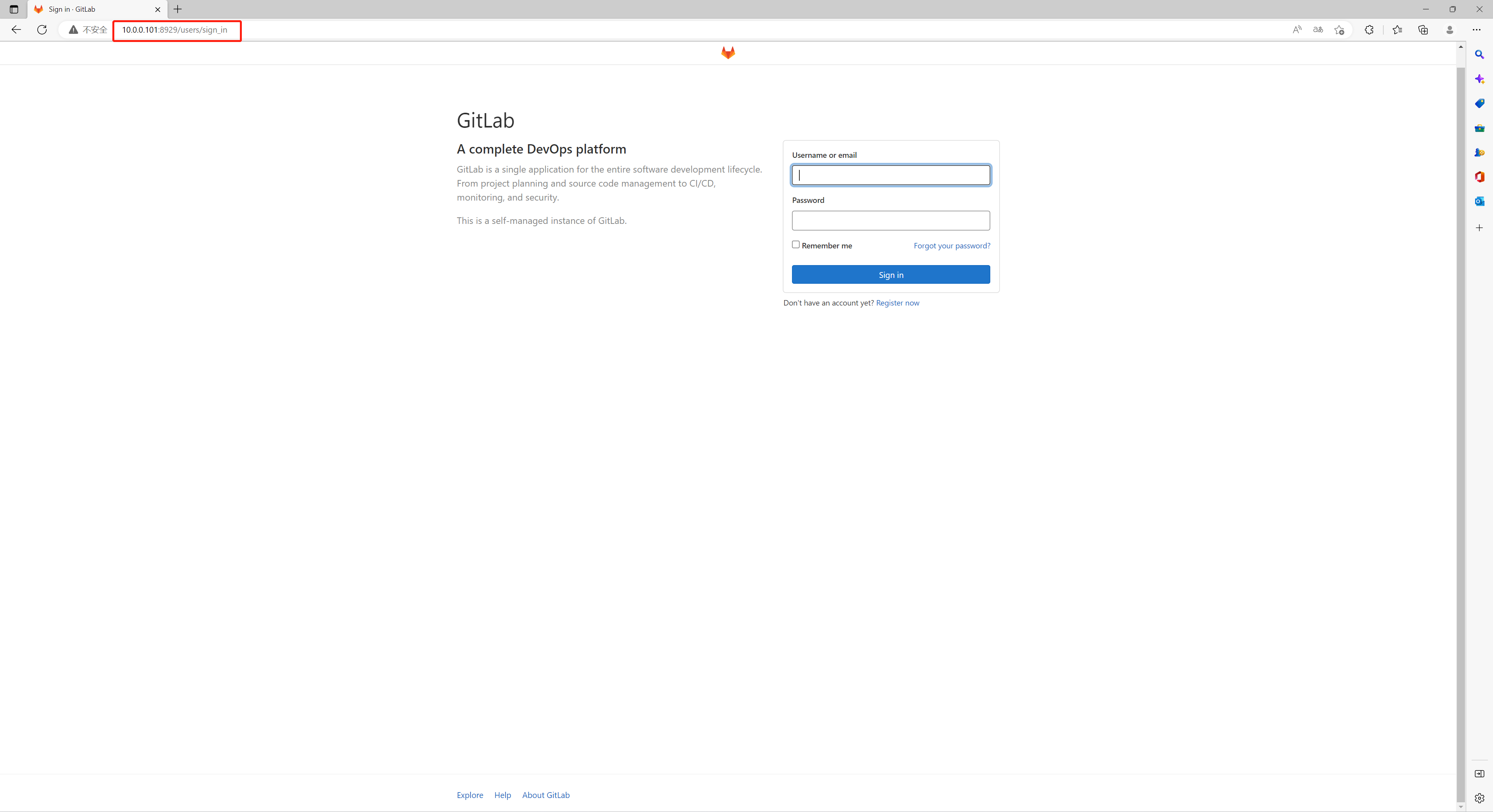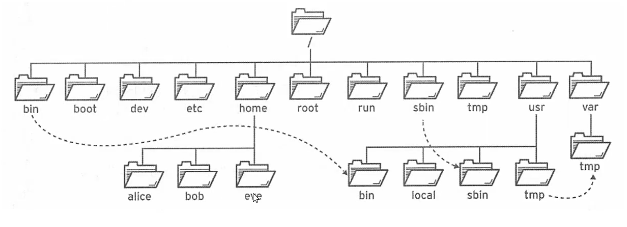一、事务
Redis事务:redis可以保证一条命令原子性,但是不保证多条命令的原子性
Redis隔离级别:不存在隔离级别的概念!
Redis事务的操作:
- 开启事务
- 命令入队
- 执行事务
# example
127.0.0.1:6379> multi # 开启事务
OK
127.0.0.1:6379> mset k1 v1 k2 v2 # 设置多个值
QUEUED # 进入队列
127.0.0.1:6379> set k3 v3 # 设置一个值
QUEUED
127.0.0.1:6379> get k2 # 获取一个值
QUEUED
127.0.0.1:6379> set k4 v4
QUEUED
127.0.0.1:6379> exec # 执行这个事务
1) OK # 设置成功
2) OK # 设置成功
3) "v2" # 获取到了k2的值
4) OK # 设置成功
###################################################
# 取消事务
127.0.0.1:6379> flushdb # 清空redis
OK
127.0.0.1:6379> multi # 开启事务
OK
127.0.0.1:6379> set key1 value1
QUEUED
127.0.0.1:6379> mset k2 v2 k3 v3 k4 v4 # 设置值
QUEUED
127.0.0.1:6379> DISCARD # 取消事务
OK
127.0.0.1:6379> get key1 # 因为事务的取消 导致set设置的值没有
(nil)
###################################################
# Redis事务(多条语句下)不支持原子性
127.0.0.1:6379> set k1 "v1" # 设置一个字符串
OK
127.0.0.1:6379> multi # 开启事务
OK
127.0.0.1:6379> incr k1 # 对字符串进行自增,明显会报错
QUEUED
127.0.0.1:6379> set k2 c2 # 设置一个k2
QUEUED
127.0.0.1:6379> set k4 v5 # 设置k4
QUEUED
127.0.0.1:6379> exec # 执行事务
1) (error) ERR value is not an integer or out of range
2) OK
3) OK
127.0.0.1:6379> get k4 # 即使自增报错,依旧可以拿到后面设置的值
"v5"
Redis多线程下乐观锁实现
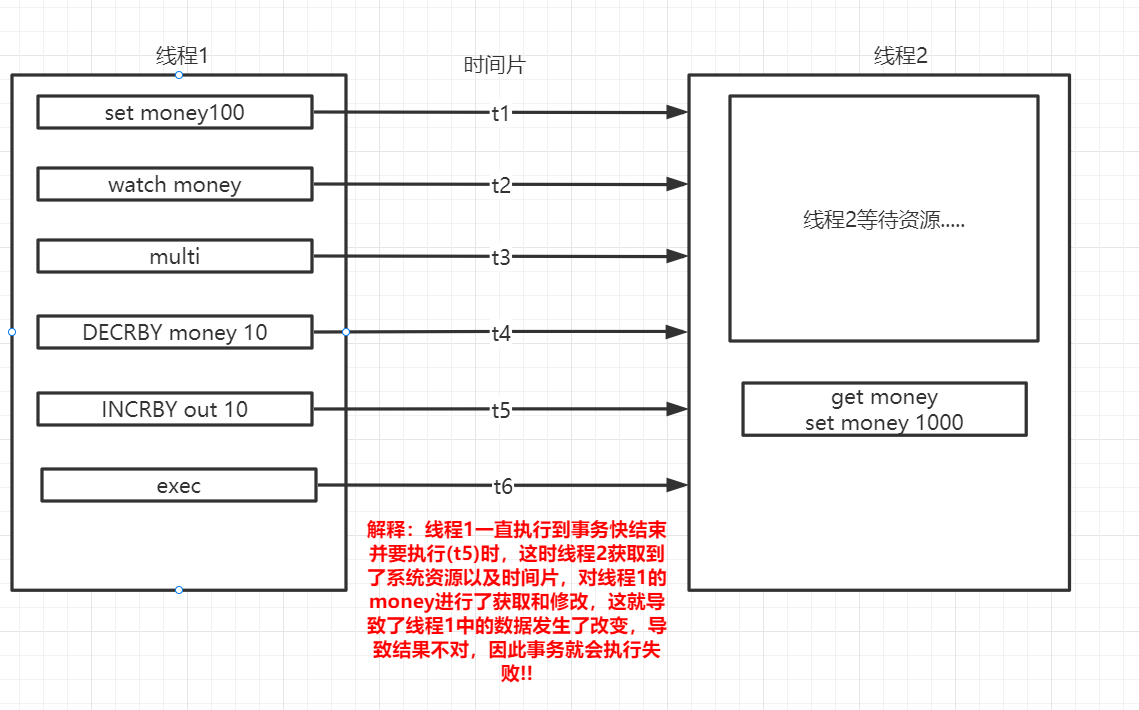
# 线程1
127.0.0.1:6379> set flower 100 # 设置一个值
OK
127.0.0.1:6379> get flower # 查看
"100"
127.0.0.1:6379> watch flower # 监视这个key
OK
127.0.0.1:6379> multi # 开启事务
OK
127.0.0.1:6379> DECRBY flower 10 # 对flower总体进行减法操作
QUEUED
127.0.0.1:6379> INCRBY out 10 # 既然flower减法操作了,那么就对应有加法操作
QUEUED
127.0.0.1:6379> exec # 执行事务
(nil)
# 线程2
127.0.0.1:6379> get flower # 在线程1还未执行事务的时候,就抢占了资源,先查看了flower
"100"
127.0.0.1:6379> set flower 1000 # 再对flower进行了操作, 那么线程1的flower值肯定不对了,这就导致了乐观锁的失败!!
OK
解决方案
# 线程1
127.0.0.1:6379> exec
1) (integer) 700
2) (integer) 300
127.0.0.1:6379> unwatch # 放弃监视
OK
127.0.0.1:6379> watch flower # 再次监视
OK
127.0.0.1:6379> multi
OK
127.0.0.1:6379> INCRBY flower 300 # 加上300
QUEUED
127.0.0.1:6379> DECRBY out 300 # 减少300
QUEUED
127.0.0.1:6379> exec
1) (integer) 1000
2) (integer) 0
# 线程2 只获取了key,并没有修改,而线程1就不断的尝试,只要线程2不对数据进行修改就可以达到成功!!
127.0.0.1:6379> get flower
"700"
127.0.0.1:6379> get flower
"700"
127.0.0.1:6379> get flower
"1000"
- 乐观锁:乐观锁是一种不实际加锁的过程,在运行过程中,就以为它就是不会改变,在redis中乐观锁就可以用watch和unwatch实现,通过watch监视,当乐观锁失败时,就使用unwatch取消监视然后又再次watch监视,再执行相同的操作,可以自己设置重试的次数,当某一次在线程1执行事务中,未被线程2抢占时间片去修改,那么线程1的事务就可以执行成功!

Redis 多线程
二、Springboot集成Redis
- spring-boot-starter-data-redis版本在2.xxx之后采用的是lettuce作为redis的操作类型,它很好的支持了多线程并发下的线程安全问题(底层通信采用了netty),而原来的jedis在多线程情况下会出现线程不安全的情况
导入依赖
<dependency>
<groupId>org.springframework.boot</groupId>
<artifactId>spring-boot-starter-data-redis</artifactId>
<version>2.5.5</version>
</dependency>
RedisTemplate
- 如果不自定义RedisTemplate,springboot就会自动使用他装配的默认RedisTemplate
@Configuration(
proxyBeanMethods = false
)
@ConditionalOnClass({RedisOperations.class})
@EnableConfigurationProperties({RedisProperties.class})
@Import({LettuceConnectionConfiguration.class, JedisConnectionConfiguration.class})
public class RedisAutoConfiguration {
public RedisAutoConfiguration() {
}
@Bean
@ConditionalOnMissingBean(
name = {"redisTemplate"}
)
// ConditionalOnSingleCandidate表示如果没有自定义RedisTemplate这个类那么springboot自带的RedisTemplate就会生效!
@ConditionalOnSingleCandidate(RedisConnectionFactory.class)
public RedisTemplate<Object, Object> redisTemplate(RedisConnectionFactory redisConnectionFactory) {
RedisTemplate<Object, Object> template = new RedisTemplate();
template.setConnectionFactory(redisConnectionFactory);
return template;
}
@Bean
@ConditionalOnMissingBean
@ConditionalOnSingleCandidate(RedisConnectionFactory.class)
public StringRedisTemplate stringRedisTemplate(RedisConnectionFactory redisConnectionFactory) {
StringRedisTemplate template = new StringRedisTemplate();
template.setConnectionFactory(redisConnectionFactory);
return template;
}
}
- 自定义RedisTemplate
RedisTemplate需要进行序列化,不然存储的对象或者中文都无法进行正常的读取,可能会出现乱码行为
/**
* RedisTemplate通用模板
* @param factory
* @return
*/
@Bean(name = "redisTemplate")
@SuppressWarnings("all")
public RedisTemplate<String, Object> redisTemplate(RedisConnectionFactory factory) {
RedisTemplate<String, Object> template = new RedisTemplate<>();
template.setConnectionFactory(factory);
//(1)Json序列化配置
Jackson2JsonRedisSerializer jackson2JsonRedisSerializer = new Jackson2JsonRedisSerializer(Object.class);
ObjectMapper om = new ObjectMapper();
om.setVisibility(PropertyAccessor.ALL, JsonAutoDetect.Visibility.ANY);
//过期方法
//om.enableDefaultTyping(ObjectMapper.DefaultTyping.NON_FINAL);
/**
* Jackson ObjectMapper 中的 enableDefaultTyping 方法由于安全原因,
* 从 2.10.0 开始标记为过期,建议用 activateDefaultTyping 方法代替,
* 所以如果继续使用 enableDefaultTyping 会有警告出现,我们现在要消除这个警告,
* 去看一下 enableDefaultTyping 源码
*/
om.activateDefaultTyping(
LaissezFaireSubTypeValidator.instance,
ObjectMapper.DefaultTyping.NON_FINAL,
JsonTypeInfo.As.WRAPPER_ARRAY);
jackson2JsonRedisSerializer.setObjectMapper(om);
//(2)String的序列化
RedisSerializer<String> stringRedisSerializer = new StringRedisSerializer();
//序列化设置,这样为了存储操作对象时正常显示的数据,也能正常存储和获取
//key采用String的序列化方式
template.setKeySerializer(stringRedisSerializer);
//hash的key采用String序列化
template.setHashKeySerializer(stringRedisSerializer);
//value采用Json序列化
template.setValueSerializer(jackson2JsonRedisSerializer);
//hash的value采用json序列化
template.setHashValueSerializer(jackson2JsonRedisSerializer);
template.afterPropertiesSet();
return template;
}
自定义RedisUtil实现对RedisTemplate的再次封装
- 使用RedisTemplate<String, Object> 底层api比较繁琐,可以自定义一个Redis工具类来实现并达到像操作redis命令行的操作!
// 通用模板RedisTemplate<String, Object>
package com.example.utils;
import org.springframework.beans.factory.annotation.Autowired;
import org.springframework.data.redis.connection.DataType;
import org.springframework.data.redis.core.Cursor;
import org.springframework.data.redis.core.RedisTemplate;
import org.springframework.data.redis.core.ScanOptions;
import org.springframework.data.redis.core.ZSetOperations;
import org.springframework.stereotype.Component;
import redis.clients.jedis.Connection;
import java.util.*;
import java.util.concurrent.TimeUnit;
/**
* @author XiaZh
* @version v1.0
* @Description :
* Created on 2021/10/11.
*/
@Component
public class RedisUtil {
@Autowired
private RedisTemplate<String, Object> redisTemplate;
/**
* 设置过期时间
* @param key
* @param time
* @param unit
* @return
*/
public Boolean expire(String key, Long time, TimeUnit unit) {
return redisTemplate.expire(key, time, unit);
}
/**
* 删除一个key
* @param key
*/
public void delete(String key) {
redisTemplate.delete(key);
}
/**
* 批量删除key
* @param keys
*/
public void delete(Collection<String> keys) {
redisTemplate.delete(keys);
}
/**
* 序列化key
* @param key
* @return
*/
public byte[] dump(String key) {
return redisTemplate.dump(key);
}
/**
* 是否存在key
*
* @param key
* @return
*/
public Boolean hasKey(String key) {
return redisTemplate.hasKey(key);
}
/**
* 设置过期时间
*
* @param key
* @param timeout
* @param unit
* @return
*/
public Boolean expire(String key, long timeout, TimeUnit unit) {
return redisTemplate.expire(key, timeout, unit);
}
/**
* 设置过期时间
*
* @param key
* @param date
* @return
*/
public Boolean expireAt(String key, Date date) {
return redisTemplate.expireAt(key, date);
}
/**
* 查找匹配的key
*
* @param pattern
* @return
*/
public Set<String> keys(String pattern) {
return redisTemplate.keys(pattern);
}
/**
* 将当前数据库的 key 移动到给定的数据库 db 当中
*
* @param key
* @param dbIndex
* @return
*/
public Boolean move(String key, int dbIndex) {
return redisTemplate.move(key, dbIndex);
}
/**
* 移除 key 的过期时间,key 将持久保持
*
* @param key
* @return
*/
public Boolean persist(String key) {
return redisTemplate.persist(key);
}
/**
* 返回 key 的剩余的过期时间
*
* @param key
* @param unit
* @return
*/
public Long getExpire(String key, TimeUnit unit) {
return redisTemplate.getExpire(key, unit);
}
/**
* 返回 key 的剩余的过期时间
*
* @param key
* @return
*/
public Long getExpire(String key) {
return redisTemplate.getExpire(key);
}
/**
* 从当前数据库中随机返回一个 key
*
* @return
*/
public String randomKey() {
return redisTemplate.randomKey();
}
/**
* 修改 key 的名称
*
* @param oldKey
* @param newKey
*/
public void rename(String oldKey, String newKey) {
redisTemplate.rename(oldKey, newKey);
}
/**
* 仅当 newkey 不存在时,将 oldKey 改名为 newkey
*
* @param oldKey
* @param newKey
* @return
*/
public Boolean renameIfAbsent(String oldKey, String newKey) {
return redisTemplate.renameIfAbsent(oldKey, newKey);
}
/**
* 返回 key 所储存的值的类型
*
* @param key
* @return
*/
public DataType type(String key) {
return redisTemplate.type(key);
}
/** -------------------string相关操作--------------------- */
/**
* 设置指定 key 的值
* @param key
* @param value
*/
public void set(String key, Object value) {
redisTemplate.opsForValue().set(key, value);
}
/**
* 获取指定 key 的值
* @param key
* @return
*/
public Object get(String key) {
return redisTemplate.opsForValue().get(key);
}
/**
* 返回 key 中字符串值的子字符
* @param key
* @param start
* @param end
* @return
*/
public String getRange(String key, long start, long end) {
return redisTemplate.opsForValue().get(key, start, end);
}
/**
* 将给定 key 的值设为 value ,并返回 key 的旧值(old value)
*
* @param key
* @param value
* @return
*/
public Object getAndSet(String key, Object value) {
return redisTemplate.opsForValue().getAndSet(key, value);
}
/**
* 对 key 所储存的字符串值,获取指定偏移量上的位(bit)
*
* @param key
* @param offset
* @return
*/
public Boolean getBit(String key, long offset) {
return redisTemplate.opsForValue().getBit(key, offset);
}
/**
* 批量获取
*
* @param keys
* @return
*/
public List<Object> multiGet(Collection<String> keys) {
return redisTemplate.opsForValue().multiGet(keys);
}
/**
* 设置ASCII码, 字符串'a'的ASCII码是97, 转为二进制是'01100001', 此方法是将二进制第offset位值变为value
*
* @param key
* @param value
* 值,true为1, false为0
* @return
*/
public boolean setBit(String key, long offset, boolean value) {
return redisTemplate.opsForValue().setBit(key, offset, value);
}
/**
* 将值 value 关联到 key ,并将 key 的过期时间设为 timeout
*
* @param key
* @param value
* @param timeout
* 过期时间
* @param unit
* 时间单位, 天:TimeUnit.DAYS 小时:TimeUnit.HOURS 分钟:TimeUnit.MINUTES
* 秒:TimeUnit.SECONDS 毫秒:TimeUnit.MILLISECONDS
*/
public void setEx(String key, Object value, long timeout, TimeUnit unit) {
redisTemplate.opsForValue().set(key, value, timeout, unit);
}
/**
* 只有在 key 不存在时设置 key 的值
*
* @param key
* @param value
* @return 之前已经存在返回false,不存在返回true
*/
public boolean setIfAbsent(String key, Object value) {
return redisTemplate.opsForValue().setIfAbsent(key, value);
}
/**
* 用 value 参数覆写给定 key 所储存的字符串值,从偏移量 offset 开始
*
* @param key
* @param value
* @param offset
* 从指定位置开始覆写
*/
public void setRange(String key, String value, long offset) {
redisTemplate.opsForValue().set(key, value, offset);
}
/**
* 获取字符串的长度
*
* @param key
* @return
*/
public Long size(String key) {
return redisTemplate.opsForValue().size(key);
}
/**
* 批量添加
*
* @param maps
*/
public void multiSet(Map<String, String> maps) {
redisTemplate.opsForValue().multiSet(maps);
}
/**
* 同时设置一个或多个 key-value 对,当且仅当所有给定 key 都不存在
*
* @param maps
* @return 之前已经存在返回false,不存在返回true
*/
public boolean multiSetIfAbsent(Map<String, String> maps) {
return redisTemplate.opsForValue().multiSetIfAbsent(maps);
}
/**
* 增加(自增长), 负数则为自减
*
* @param key
* @return
*/
public Long incrBy(String key, long increment) {
return redisTemplate.opsForValue().increment(key, increment);
}
/**
* 增加(自增长), 负数则为自减
* @param key
* @return
*/
public Double incrByFloat(String key, double increment) {
return redisTemplate.opsForValue().increment(key, increment);
}
/**
* 追加到末尾
*
* @param key
* @param value
* @return
*/
public Integer append(String key, String value) {
return redisTemplate.opsForValue().append(key, value);
}
/** -------------------hash相关操作------------------------- */
/**
* 获取存储在哈希表中指定字段的值
*
* @param key
* @param field
* @return
*/
public Object hGet(String key, String field) {
return redisTemplate.opsForHash().get(key, field);
}
/**
* 获取所有给定字段的值
*
* @param key
* @return
*/
public Map<Object, Object> hGetAll(String key) {
return redisTemplate.opsForHash().entries(key);
}
/**
* 获取所有给定字段的值
*
* @param key
* @param fields
* @return
*/
public List<Object> hMultiGet(String key, Collection<Object> fields) {
return redisTemplate.opsForHash().multiGet(key, fields);
}
public void hPut(String key, String hashKey, String value) {
redisTemplate.opsForHash().put(key, hashKey, value);
}
public void hPutAll(String key, Map<String, String> maps) {
redisTemplate.opsForHash().putAll(key, maps);
}
/**
* 仅当hashKey不存在时才设置
*
* @param key
* @param hashKey
* @param value
* @return
*/
public Boolean hPutIfAbsent(String key, String hashKey, String value) {
return redisTemplate.opsForHash().putIfAbsent(key, hashKey, value);
}
/**
* 删除一个或多个哈希表字段
*
* @param key
* @param fields
* @return
*/
public Long hDelete(String key, Object... fields) {
return redisTemplate.opsForHash().delete(key, fields);
}
/**
* 查看哈希表 key 中,指定的字段是否存在
*
* @param key
* @param field
* @return
*/
public boolean hExists(String key, String field) {
return redisTemplate.opsForHash().hasKey(key, field);
}
/**
* 为哈希表 key 中的指定字段的整数值加上增量 increment
*
* @param key
* @param field
* @param increment
* @return
*/
public Long hIncrBy(String key, Object field, long increment) {
return redisTemplate.opsForHash().increment(key, field, increment);
}
/**
* 为哈希表 key 中的指定字段的整数值加上增量 increment
*
* @param key
* @param field
* @param delta
* @return
*/
public Double hIncrByFloat(String key, Object field, double delta) {
return redisTemplate.opsForHash().increment(key, field, delta);
}
/**
* 获取所有哈希表中的字段
*
* @param key
* @return
*/
public Set<Object> hKeys(String key) {
return redisTemplate.opsForHash().keys(key);
}
/**
* 获取哈希表中字段的数量
*
* @param key
* @return
*/
public Long hSize(String key) {
return redisTemplate.opsForHash().size(key);
}
/**
* 获取哈希表中所有值
*
* @param key
* @return
*/
public List<Object> hValues(String key) {
return redisTemplate.opsForHash().values(key);
}
/**
* 迭代哈希表中的键值对
*
* @param key
* @param options
* @return
*/
public Cursor<Map.Entry<Object, Object>> hScan(String key, ScanOptions options) {
return redisTemplate.opsForHash().scan(key, options);
}
/** ------------------------list相关操作---------------------------- */
/**
* 通过索引获取列表中的元素
*
* @param key
* @param index
* @return
*/
public Object lIndex(String key, long index) {
return redisTemplate.opsForList().index(key, index);
}
/**
* 获取列表指定范围内的元素
*
* @param key
* @param start
* 开始位置, 0是开始位置
* @param end
* 结束位置, -1返回所有
* @return
*/
public List<Object> lRange(String key, long start, long end) {
return redisTemplate.opsForList().range(key, start, end);
}
/**
* 存储在list头部
*
* @param key
* @param value
* @return
*/
public Long lLeftPush(String key, Object value) {
return redisTemplate.opsForList().leftPush(key, value);
}
/**
*
* @param key
* @param value
* @return
*/
public Long lLeftPushAll(String key, Object... value) {
return redisTemplate.opsForList().leftPushAll(key, value);
}
/**
*
* @param key
* @param value
* @return
*/
public Long lLeftPushAll(String key, Collection<Object> value) {
return redisTemplate.opsForList().leftPushAll(key, value);
}
/**
* 当list存在的时候才加入
*
* @param key
* @param value
* @return
*/
public Long lLeftPushIfPresent(String key, Object value) {
return redisTemplate.opsForList().leftPushIfPresent(key, value);
}
/**
* 如果pivot存在,再pivot前面添加
*
* @param key
* @param pivot
* @param value
* @return
*/
public Long lLeftPush(String key, String pivot, Object value) {
return redisTemplate.opsForList().leftPush(key, pivot, value);
}
/**
*
* @param key
* @param value
* @return
*/
public Long lRightPush(String key, Object value) {
return redisTemplate.opsForList().rightPush(key, value);
}
/**
*
* @param key
* @param value
* @return
*/
public Long lRightPushAll(String key, Object... value) {
return redisTemplate.opsForList().rightPushAll(key, value);
}
/**
*
* @param key
* @param value
* @return
*/
public Long lRightPushAll(String key, Collection<Object> value) {
return redisTemplate.opsForList().rightPushAll(key, value);
}
/**
* 为已存在的列表添加值
*
* @param key
* @param value
* @return
*/
public Long lRightPushIfPresent(String key, Object value) {
return redisTemplate.opsForList().rightPushIfPresent(key, value);
}
/**
* 在pivot元素的右边添加值
*
* @param key
* @param pivot
* @param value
* @return
*/
public Long lRightPush(String key, String pivot, Object value) {
return redisTemplate.opsForList().rightPush(key, pivot, value);
}
/**
* 通过索引设置列表元素的值
*
* @param key
* @param index
* 位置
* @param value
*/
public void lSet(String key, long index, Object value) {
redisTemplate.opsForList().set(key, index, value);
}
/**
* 移出并获取列表的第一个元素
*
* @param key
* @return 删除的元素
*/
public Object lLeftPop(String key) {
return redisTemplate.opsForList().leftPop(key);
}
/**
* 移出并获取列表的第一个元素, 如果列表没有元素会阻塞列表直到等待超时或发现可弹出元素为止
*
* @param key
* @param timeout
* 等待时间
* @param unit
* 时间单位
* @return
*/
public Object lBLeftPop(String key, long timeout, TimeUnit unit) {
return redisTemplate.opsForList().leftPop(key, timeout, unit);
}
/**
* 移除并获取列表最后一个元素
*
* @param key
* @return 删除的元素
*/
public Object lRightPop(String key) {
return redisTemplate.opsForList().rightPop(key);
}
/**
* 移出并获取列表的最后一个元素, 如果列表没有元素会阻塞列表直到等待超时或发现可弹出元素为止
*
* @param key
* @param timeout
* 等待时间
* @param unit
* 时间单位
* @return
*/
public Object lBRightPop(String key, long timeout, TimeUnit unit) {
return redisTemplate.opsForList().rightPop(key, timeout, unit);
}
/**
* 移除列表的最后一个元素,并将该元素添加到另一个列表并返回
*
* @param sourceKey
* @param destinationKey
* @return
*/
public Object lRightPopAndLeftPush(String sourceKey, String destinationKey) {
return redisTemplate.opsForList().rightPopAndLeftPush(sourceKey,
destinationKey);
}
/**
* 从列表中弹出一个值,将弹出的元素插入到另外一个列表中并返回它; 如果列表没有元素会阻塞列表直到等待超时或发现可弹出元素为止
*
* @param sourceKey
* @param destinationKey
* @param timeout
* @param unit
* @return
*/
public Object lBRightPopAndLeftPush(String sourceKey, String destinationKey,
long timeout, TimeUnit unit) {
return redisTemplate.opsForList().rightPopAndLeftPush(sourceKey,
destinationKey, timeout, unit);
}
/**
* 删除集合中值等于value得元素
*
* @param key
* @param index
* index=0, 删除所有值等于value的元素; index>0, 从头部开始删除第一个值等于value的元素;
* index<0, 从尾部开始删除第一个值等于value的元素;
* @param value
* @return
*/
public Long lRemove(String key, long index, Object value) {
return redisTemplate.opsForList().remove(key, index, value);
}
/**
* 裁剪list
*
* @param key
* @param start
* @param end
*/
public void lTrim(String key, long start, long end) {
redisTemplate.opsForList().trim(key, start, end);
}
/**
* 获取列表长度
*
* @param key
* @return
*/
public Long lLen(String key) {
return redisTemplate.opsForList().size(key);
}
/** --------------------set相关操作-------------------------- */
/**
* set添加元素
*
* @param key
* @param values
* @return
*/
public Long sAdd(String key, Object... values) {
return redisTemplate.opsForSet().add(key, values);
}
/**
* set移除元素
*
* @param key
* @param values
* @return
*/
public Long sRemove(String key, Object... values) {
return redisTemplate.opsForSet().remove(key, values);
}
/**
* 移除并返回集合的一个随机元素
*
* @param key
* @return
*/
public Object sPop(String key) {
return redisTemplate.opsForSet().pop(key);
}
/**
* 将元素value从一个集合移到另一个集合
*
* @param key
* @param value
* @param destKey
* @return
*/
public Boolean sMove(String key, Object value, String destKey) {
return redisTemplate.opsForSet().move(key, value, destKey);
}
/**
* 获取集合的大小
*
* @param key
* @return
*/
public Long sSize(String key) {
return redisTemplate.opsForSet().size(key);
}
/**
* 判断集合是否包含value
*
* @param key
* @param value
* @return
*/
public Boolean sIsMember(String key, Object value) {
return redisTemplate.opsForSet().isMember(key, value);
}
/**
* 获取两个集合的交集
*
* @param key
* @param otherKey
* @return
*/
public Set<Object> sIntersect(String key, String otherKey) {
return redisTemplate.opsForSet().intersect(key, otherKey);
}
/**
* 获取key集合与多个集合的交集
*
* @param key
* @param otherKeys
* @return
*/
public Set<Object> sIntersect(String key, Collection<String> otherKeys) {
return redisTemplate.opsForSet().intersect(key, otherKeys);
}
/**
* key集合与otherKey集合的交集存储到destKey集合中
*
* @param key
* @param otherKey
* @param destKey
* @return
*/
public Long sIntersectAndStore(String key, String otherKey, String destKey) {
return redisTemplate.opsForSet().intersectAndStore(key, otherKey,
destKey);
}
/**
* key集合与多个集合的交集存储到destKey集合中
*
* @param key
* @param otherKeys
* @param destKey
* @return
*/
public Long sIntersectAndStore(String key, Collection<String> otherKeys,
String destKey) {
return redisTemplate.opsForSet().intersectAndStore(key, otherKeys,
destKey);
}
/**
* 获取两个集合的并集
*
* @param key
* @param otherKeys
* @return
*/
public Set<Object> sUnion(String key, String otherKeys) {
return redisTemplate.opsForSet().union(key, otherKeys);
}
/**
* 获取key集合与多个集合的并集
*
* @param key
* @param otherKeys
* @return
*/
public Set<Object> sUnion(String key, Collection<String> otherKeys) {
return redisTemplate.opsForSet().union(key, otherKeys);
}
/**
* key集合与otherKey集合的并集存储到destKey中
*
* @param key
* @param otherKey
* @param destKey
* @return
*/
public Long sUnionAndStore(String key, String otherKey, String destKey) {
return redisTemplate.opsForSet().unionAndStore(key, otherKey, destKey);
}
/**
* key集合与多个集合的并集存储到destKey中
*
* @param key
* @param otherKeys
* @param destKey
* @return
*/
public Long sUnionAndStore(String key, Collection<String> otherKeys,
String destKey) {
return redisTemplate.opsForSet().unionAndStore(key, otherKeys, destKey);
}
/**
* 获取两个集合的差集
*
* @param key
* @param otherKey
* @return
*/
public Set<Object> sDifference(String key, String otherKey) {
return redisTemplate.opsForSet().difference(key, otherKey);
}
/**
* 获取key集合与多个集合的差集
*
* @param key
* @param otherKeys
* @return
*/
public Set<Object> sDifference(String key, Collection<String> otherKeys) {
return redisTemplate.opsForSet().difference(key, otherKeys);
}
/**
* key集合与otherKey集合的差集存储到destKey中
*
* @param key
* @param otherKey
* @param destKey
* @return
*/
public Long sDifference(String key, String otherKey, String destKey) {
return redisTemplate.opsForSet().differenceAndStore(key, otherKey,
destKey);
}
/**
* key集合与多个集合的差集存储到destKey中
*
* @param key
* @param otherKeys
* @param destKey
* @return
*/
public Long sDifference(String key, Collection<String> otherKeys,
String destKey) {
return redisTemplate.opsForSet().differenceAndStore(key, otherKeys,
destKey);
}
/**
* 获取集合所有元素
*
* @param key
* @return
*/
public Set<Object> setMembers(String key) {
return redisTemplate.opsForSet().members(key);
}
/**
* 随机获取集合中的一个元素
*
* @param key
* @return
*/
public Object sRandomMember(String key) {
return redisTemplate.opsForSet().randomMember(key);
}
/**
* 随机获取集合中count个元素
*
* @param key
* @param count
* @return
*/
public List<Object> sRandomMembers(String key, long count) {
return redisTemplate.opsForSet().randomMembers(key, count);
}
/**
* 随机获取集合中count个元素并且去除重复的
*
* @param key
* @param count
* @return
*/
public Set<Object> sDistinctRandomMembers(String key, long count) {
return redisTemplate.opsForSet().distinctRandomMembers(key, count);
}
/**
*
* @param key
* @param options
* @return
*/
public Cursor<Object> sScan(String key, ScanOptions options) {
return redisTemplate.opsForSet().scan(key, options);
}
/**------------------zSet相关操作--------------------------------*/
/**
* 添加元素,有序集合是按照元素的score值由小到大排列
*
* @param key
* @param value
* @param score
* @return
*/
public Boolean zAdd(String key, String value, double score) {
return redisTemplate.opsForZSet().add(key, value, score);
}
/**
*
* @param key
* @param values
* @return
*/
public Long zAdd(String key, Set<ZSetOperations.TypedTuple<Object>> values) {
return redisTemplate.opsForZSet().add(key, values);
}
/**
*
* @param key
* @param values
* @return
*/
public Long zRemove(String key, Object... values) {
return redisTemplate.opsForZSet().remove(key, values);
}
/**
* 增加元素的score值,并返回增加后的值
*
* @param key
* @param value
* @param delta
* @return
*/
public Double zIncrementScore(String key, Object value, double delta) {
return redisTemplate.opsForZSet().incrementScore(key, value, delta);
}
/**
* 返回元素在集合的排名,有序集合是按照元素的score值由小到大排列
*
* @param key
* @param value
* @return 0表示第一位
*/
public Long zRank(String key, Object value) {
return redisTemplate.opsForZSet().rank(key, value);
}
/**
* 返回元素在集合的排名,按元素的score值由大到小排列
*
* @param key
* @param value
* @return
*/
public Long zReverseRank(String key, Object value) {
return redisTemplate.opsForZSet().reverseRank(key, value);
}
/**
* 获取集合的元素, 从小到大排序
*
* @param key
* @param start
* 开始位置
* @param end
* 结束位置, -1查询所有
* @return
*/
public Set<Object> zRange(String key, long start, long end) {
return redisTemplate.opsForZSet().range(key, start, end);
}
/**
* 获取集合元素, 并且把score值也获取
*
* @param key
* @param start
* @param end
* @return
*/
public Set<ZSetOperations.TypedTuple<Object>> zRangeWithScores(String key, long start,
long end) {
return redisTemplate.opsForZSet().rangeWithScores(key, start, end);
}
/**
* 根据Score值查询集合元素
*
* @param key
* @param min
* 最小值
* @param max
* 最大值
* @return
*/
public Set<Object> zRangeByScore(String key, double min, double max) {
return redisTemplate.opsForZSet().rangeByScore(key, min, max);
}
/**
* 根据Score值查询集合元素, 从小到大排序
*
* @param key
* @param min
* 最小值
* @param max
* 最大值
* @return
*/
public Set<ZSetOperations.TypedTuple<Object>> zRangeByScoreWithScores(String key,
double min, double max) {
return redisTemplate.opsForZSet().rangeByScoreWithScores(key, min, max);
}
/**
*
* @param key
* @param min
* @param max
* @param start
* @param end
* @return
*/
public Set<ZSetOperations.TypedTuple<Object>> zRangeByScoreWithScores(String key,
double min, double max, long start, long end) {
return redisTemplate.opsForZSet().rangeByScoreWithScores(key, min, max,
start, end);
}
/**
* 获取集合的元素, 从大到小排序
*
* @param key
* @param start
* @param end
* @return
*/
public Set<Object> zReverseRange(String key, long start, long end) {
return redisTemplate.opsForZSet().reverseRange(key, start, end);
}
/**
* 获取集合的元素, 从大到小排序, 并返回score值
*
* @param key
* @param start
* @param end
* @return
*/
public Set<ZSetOperations.TypedTuple<Object>> zReverseRangeWithScores(String key,
long start, long end) {
return redisTemplate.opsForZSet().reverseRangeWithScores(key, start,
end);
}
/**
* 根据Score值查询集合元素, 从大到小排序
*
* @param key
* @param min
* @param max
* @return
*/
public Set<Object> zReverseRangeByScore(String key, double min,
double max) {
return redisTemplate.opsForZSet().reverseRangeByScore(key, min, max);
}
/**
* 根据Score值查询集合元素, 从大到小排序
*
* @param key
* @param min
* @param max
* @return
*/
public Set<ZSetOperations.TypedTuple<Object>> zReverseRangeByScoreWithScores(
String key, double min, double max) {
return redisTemplate.opsForZSet().reverseRangeByScoreWithScores(key,
min, max);
}
/**
*
* @param key
* @param min
* @param max
* @param start
* @param end
* @return
*/
public Set<Object> zReverseRangeByScore(String key, double min,
double max, long start, long end) {
return redisTemplate.opsForZSet().reverseRangeByScore(key, min, max,
start, end);
}
/**
* 根据score值获取集合元素数量
*
* @param key
* @param min
* @param max
* @return
*/
public Long zCount(String key, double min, double max) {
return redisTemplate.opsForZSet().count(key, min, max);
}
/**
* 获取集合大小
*
* @param key
* @return
*/
public Long zSize(String key) {
return redisTemplate.opsForZSet().size(key);
}
/**
* 获取集合大小
*
* @param key
* @return
*/
public Long zZCard(String key) {
return redisTemplate.opsForZSet().zCard(key);
}
/**
* 获取集合中value元素的score值
*
* @param key
* @param value
* @return
*/
public Double zScore(String key, Object value) {
return redisTemplate.opsForZSet().score(key, value);
}
/**
* 移除指定索引位置的成员
*
* @param key
* @param start
* @param end
* @return
*/
public Long zRemoveRange(String key, long start, long end) {
return redisTemplate.opsForZSet().removeRange(key, start, end);
}
/**
* 根据指定的score值的范围来移除成员
*
* @param key
* @param min
* @param max
* @return
*/
public Long zRemoveRangeByScore(String key, double min, double max) {
return redisTemplate.opsForZSet().removeRangeByScore(key, min, max);
}
/**
* 获取key和otherKey的并集并存储在destKey中
*
* @param key
* @param otherKey
* @param destKey
* @return
*/
public Long zUnionAndStore(String key, String otherKey, String destKey) {
return redisTemplate.opsForZSet().unionAndStore(key, otherKey, destKey);
}
/**
*
* @param key
* @param otherKeys
* @param destKey
* @return
*/
public Long zUnionAndStore(String key, Collection<String> otherKeys,
String destKey) {
return redisTemplate.opsForZSet()
.unionAndStore(key, otherKeys, destKey);
}
/**
* 交集
*
* @param key
* @param otherKey
* @param destKey
* @return
*/
public Long zIntersectAndStore(String key, String otherKey,
String destKey) {
return redisTemplate.opsForZSet().intersectAndStore(key, otherKey,
destKey);
}
/**
* 交集
*
* @param key
* @param otherKeys
* @param destKey
* @return
*/
public Long zIntersectAndStore(String key, Collection<String> otherKeys,
String destKey) {
return redisTemplate.opsForZSet().intersectAndStore(key, otherKeys,
destKey);
}
/**
*
* @param key
* @param options
* @return
*/
public Cursor<ZSetOperations.TypedTuple<Object>> zScan(String key, ScanOptions options) {
return redisTemplate.opsForZSet().scan(key, options);
}
}
三、Redis.config
网络
- bind 127.0.0.1 // 绑定的ip地址
- protected-mode yes // 保护模式
- port 6379 // 端口设置
通用的GENERAL
-
daemonize // 以守护进程的方式运行 ,默认为no,需要手动开启(如果不开启的话,客户端退出 就会导致断开连接)
-
pidfile /var/run/redis_6379.pid // 后台自动运行,须指定一个pid文件
-
loglevel notice // 日志级别 (默认生产环境)
-
logfile “ ” // 日志的文件位置
-
database 16 // 数据库的个数
-
always-show-logo yes // 总是显示logo
快照
- 持久化 -> 在规定的时间内,执行了多少次操作,会持久化到.rdb .aof
save 300 1 # 如果在300s内进行了1次操作,就会执行持久化
save 100 5 # 如果在100s内进行了5次操作,就会执行持久化
save 60 10 # 如果在60s内进行了10次操作,就会执行持久化
stop-writes-on-bgsave-error yes # 持久化如果出错 设置为yes就是继续工作,改为no就取消工作
rdbcompression yes # 是否压缩rdb文件,需要消耗cpu资源
rdbchecksum yes # 保存rdb文件 并进行错误校验
dir ./ # rdb默认保存的目录(当前目录)
Security 密码设置
127.0.0.1:6379> config get requirepass # 获取密码,默认为空1) "requirepass"2) ""127.0.0.1:6379> config set requirepass "ahui" # 设置密码OK127.0.0.1:6379> ping # 当设置密码 再去ping就需要进行登录校验(error) NOAUTH Authentication required.127.0.0.1:6379> auth ahui # 登录校验成功OK127.0.0.1:6379> ping # 再次ping就会显示为通的PONG127.0.0.1:6379> config get requirepass # 获取redis登录密码1) "requirepass"2) "ahui"
append only 模式 aof配置
-
appendonly no // 默认不开启aof模式,默认是rdb方式持久化
-
appendfilename "appendonly.aof" // 持久化的文件名字
-
appendfsync always // 每次修改都会sync 消耗性能
-
appendfsync everysec // 每秒执行一次sync 可能会丢失这1s的数据 (默认)
-
appendfsync no //不执行sync,这个时候操作系统自己同步数据,速度最快
四、Redis持久化
RDB理论理解:
rdb的持久化方式:在一定的时间间隔内将数据集的内存快照(snapshotting)保存到硬盘中去(下面的RDB触发规则)。
rdb的原理:他其实是通过fork一个子进程来专门进行持久化,会先将数据写入到一个临时文件里面,然后待持久化全部结束之后,再将这个临时文件去替换上次已经持久化好的文件(dump.rdb)。这个全程他的服务进程是不用去操作的,所以启动效率很高,性能也比较好,但是会在redis突然挂掉的时候,会出现最后一次数据丢失的问题。至于原因下面会讲到
RDB 触发规则
- 1、save
- save 300 1 # 如果在300s内进行了1次操作,就会执行持久化
save 100 5 # 如果在100s内进行了5次操作,就会执行持久化
save 60 10 # 如果在60s内进行了10次操作,就会执行持久化
- save 300 1 # 如果在300s内进行了1次操作,就会执行持久化
- 2、执行flushall命令,也会触发rdb规则
- 3、退出redis(shutdown),也会触发rdb规则
- 4、bgsave(bgsave命令会创建一个子进程,由子进程来负责创建RDB文件,父进程(即Redis主进程)则继续处理请求)
bgsave命令执行过程中,只有fork子进程时会阻塞服务器,而对于save命令,整个过程都会阻塞服务器,因此save已基本被废弃,线上环境要杜绝save的使用;后文中也将只介绍bgsave命令。此外,在自动触发RDB持久化时,Redis也会选择bgsave而不是save来进行持久化;下面介绍自动触发RDB持久化的条件。
恢复rdb文件
-
只需要将rdb文件放在redis的启动目录下,redis启动时会自动检查并恢复数据
-
查看需要存放的位置
config get dir
只使用redis的缓存功能,而不使用redis 的持久化功能
redis-cli config set save " "
AOF理论理解:
AOF默认是不开启的,是需要在redis.config中进行开启
Redis的AOF会像log日志一样的格式在.aof文件中进行追加操作的命令
Redis先将写命令追加到缓冲区,而不是直接写入文件,主要是为了避免每次有写命令都直接写入硬盘,导致硬盘IO成为Redis负载的瓶颈。
命令追加的格式是Redis命令请求的协议格式,它是一种纯文本格式,具有兼容性好、可读性强、容易处理、操作简单避免二次开销等优点;具体格式略。在AOF文件中,除了用于指定数据库的select命令(如select 0 为选中0号数据库)是由Redis添加的,其他都是客户端发送来的写命令。
五、发布订阅
使用场景:实时聊天系统.. 订阅关注系统....
模型:
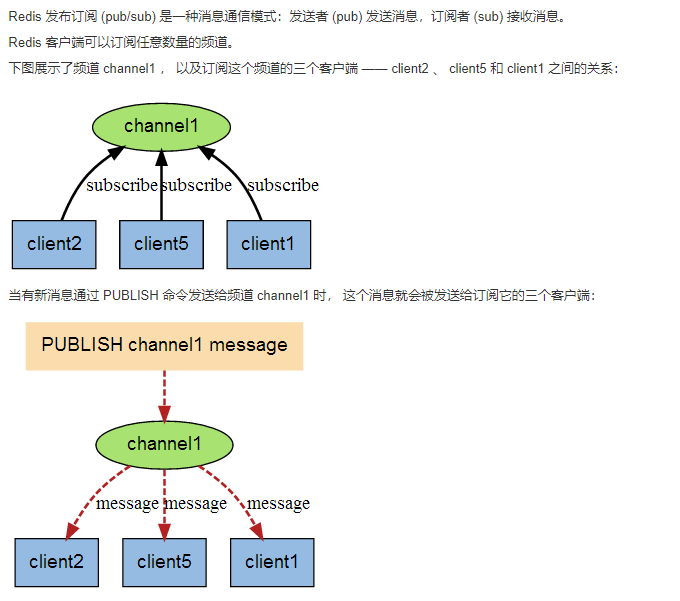
栗子:
发布方
127.0.0.1:6379> PUBLISH ahui hello # 发布的频道及内容
(integer) 1
127.0.0.1:6379> PUBLISH ahui sayredis!
(integer) 1
127.0.0.1:6379> PUBLISH ahui test!!!
(integer) 1
订阅方(一个或多个)
127.0.0.1:6379> SUBSCRIBE ahui
Reading messages... (press Ctrl-C to quit)
1) "subscribe" # 订阅此频道ahui
2) "ahui"
3) (integer) 1
1) "message" # 当发布方发送数据到队列中时,可以及时收到
2) "ahui"
3) "hello"
1) "message"
2) "ahui"
3) "sayredis!"
1) "message"
2) "ahui"
3) "test!!!"
命令用法
SUBSCRIBE ahui # 订阅方订阅频道
PUBLISH ahui hello [...channel] # 发布方发布频道及内容(可以同时订阅多个)
PUBSUB channels # 查看订阅与发布系统状态
PUNSUBSCRIBE ahui [...channel] # 退订所以给定模式的频道信息
1) "punsubscribe"
2) "ahui"
3) (integer) 0
UNSUBSCRIBE ahui # 退订指定的频道
1) "unsubscribe"
2) "ahui"
3) (integer) 0
六、主从复制
概述
主从复制:在大数据的信息量下,单台数据库的读写压力很大,以至于到现在推出的读写分离模式,即使用主从复制实现读写分离,在Redis中一般超过20G的话,redis的读写压力就很大了,需要做读写分离来实现对数据库的优化,主从复制就可以很好的实现读写分离,主机主要用于写的操作,而从机就可以实现读取的功能!
模型
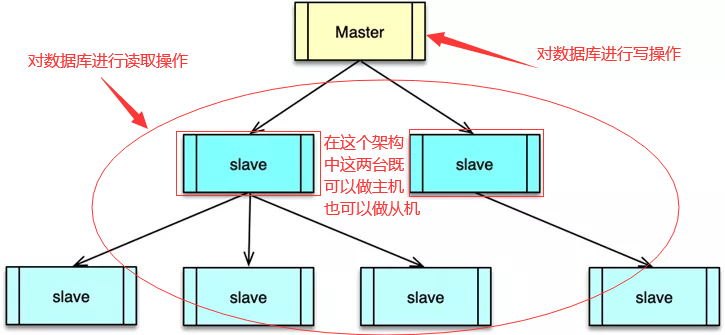
主从配置命令(暂时性)
replicaof <masterip> <masterport> # 在从机中配置主机ip + port
info replication # 查看主从机复制的信息
修改主从配置
- 在.conf 中有一个replicaof,默认是注释的,可以进行打开,然后配置主机的相关信息
主从复制注意事项
- 在主机宕机的情况下,这个主从复制就没有了写入的操作,但是还可以进行读取。
- 在主从复制中,从机如果进行写的操作,就会报错
- 在主机宕机后,修复好再次启动并进行写,从机依旧可以拿到主机的写入操作
复制方式及原理
- 主库 master 和从库 slave 之间通过复制 id 进行匹配,避免 slave 挂到错误的 master
- slave启动后,会向主机master发出sync同步命令
- master会将传送整个数据文件传输到slave从机,这就完成了一次同步
- 全量复制:slave第一次连接会进行全量复制,把master的数据全部同步,并加载到内存中
- 增量复制:master会将写入的操作,依次传递到从机slave上,完成同步
- master 在分发写请求时,同时会将写指令复制一份存入复制积压缓冲,这样当 slave 短时间断开重连时
主从复制的优缺点
- 优点
- 高可靠性:可以保证数据的完整性,也就是主机宕机了会有从机保证数据,从机宕机也可以采用sync同步
- 读写分离策略:主机主要负责数据的写入操作,而从机负责主机的同步,以及读取操作。
- 缺点
- 故障恢复复杂,如果主机宕机了且没有哨兵模式的话,就需要手动去重新选举一个主机来替代原来的主机。
- 主机的写入能力受限于单机操作,当写入操作较多时,主机可以考虑分片操作
- 主机的存储能力受限于单机操作,当存储较多时,可以采用Pika
主机宕机,手动设置更改从机为主机
- slaveof no one # 在主节点宕机后,从机使用此命令可以让自己升级为主机,当原来主节点修复好了,再次连接,它也不再是主节点!!!
七、哨兵模式
概念:哨兵模式就是来解决主机宕机后,主机的自动重新选举!!
主从复制中单哨兵模式的应用
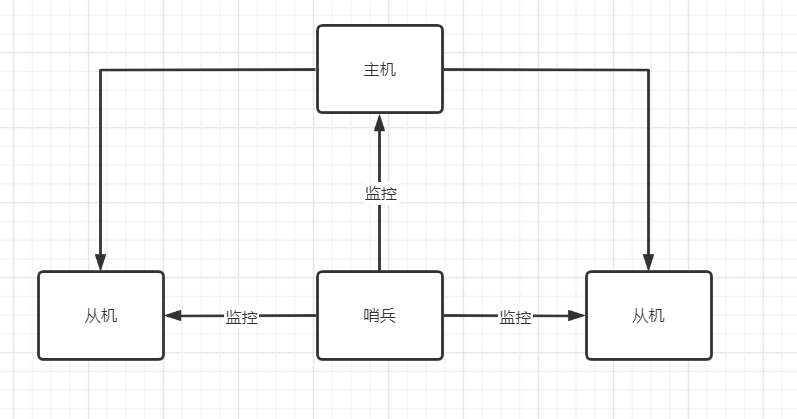
#配置端口
port 76379
#以守护进程模式启动
daemonize yes
#日志文件名
logfile "sentinel_76379.log"
#存放备份文件以及日志等文件的目录
dir "/opt/redis/data"
#监控的IP 端口号 名称 sentinel通过投票后认为mater宕机的数量,此处为至少2个
sentinel monitor mymaster 192.168.14.101 6379 2
#30秒ping不通主节点的信息,主观认为master宕机
sentinel down-after-milliseconds mymaster 30000
#故障转移后重新主从复制,1表示串行,>1并行
sentinel parallel-syncs mymaster 1
#故障转移开始,三分钟内没有完成,则认为转移失败
sentinel failover-timeout mymaster 180000
Linux上启动哨兵
redis-sentinel sentinel.conf
单哨兵弊端
- 如果哨兵宕机了,也就代表着主机宕机的话,无法再自动的选取从机取代主机
哨兵集群
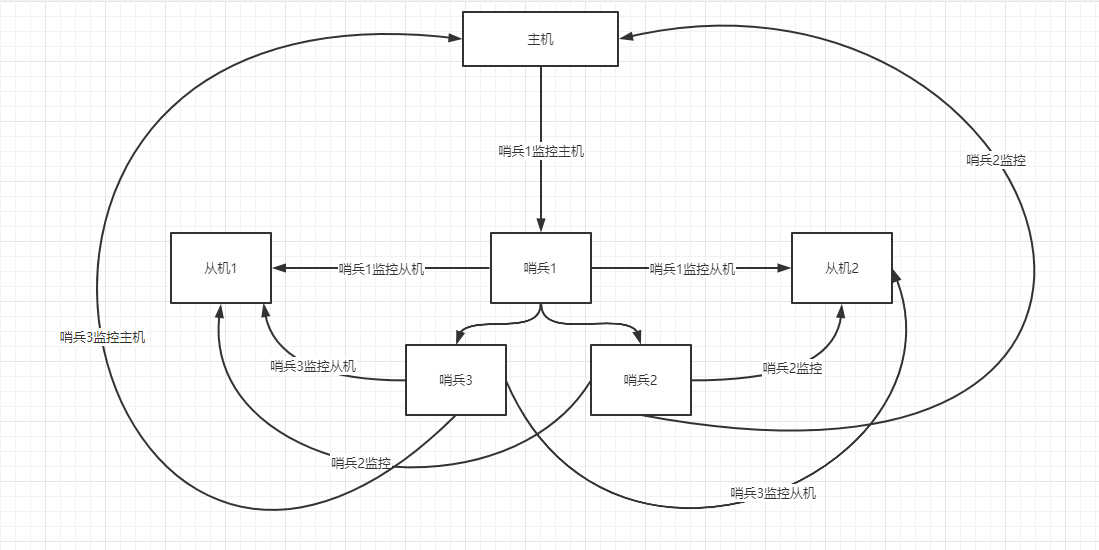
- 主节点参数
port 6377
daemonize yes
logfile "6377.log"
dbfilename "dump-6377.rdb"
- 从节点1参数
port 6379
daemonize yes
logfile "6379.log"
dbfilename "dump-6379.rdb"
slaveof 127.0.0.1 6377
- 从节点2参数
port 6380
daemonize yes
logfile "6380.log"
dbfilename "dump-6380.rdb"
slaveof 127.0.0.1 6377
多哨兵模式缺点
- 在多哨兵模式下,效率和安全得到了很大的提升,但是多哨兵模式的配置就很繁琐,主哨兵宕机也会像主从复制机制那样,重新选举一个主哨兵来进行监控
八、缓存穿透和雪崩(大面积查询且查不到)
正常查询数据库
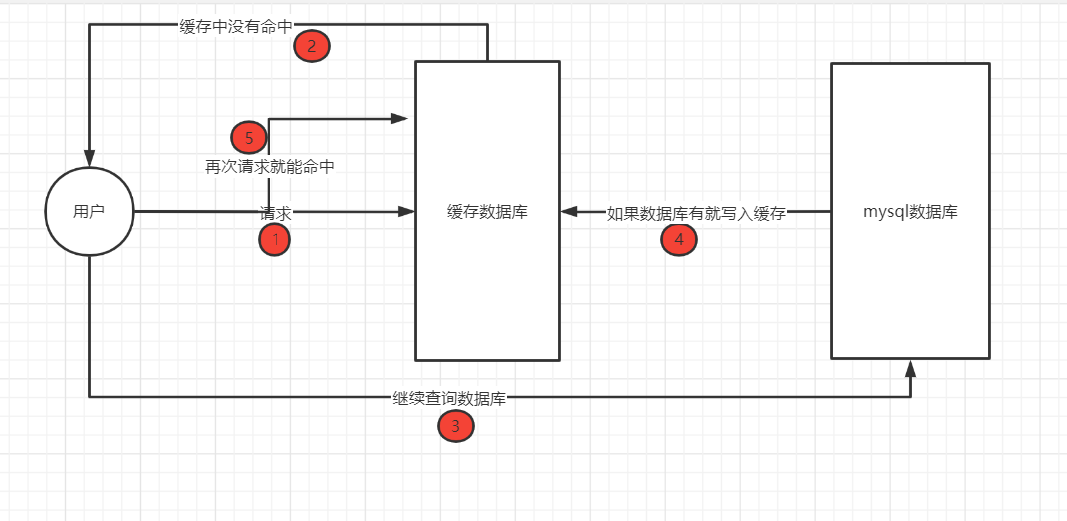
导致缓存穿透
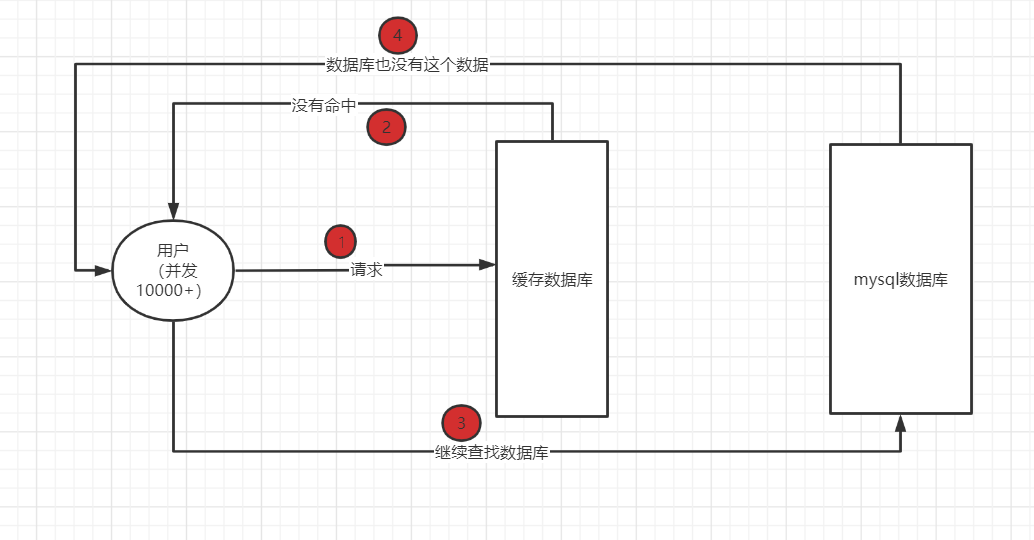
原因
- 1、并发情况下,10000+用户不断请求缓存,但缓存都没有这个数据
- 2、用户又不断去请求mysql数据库,mysql也没有这个数据就导致了缓存穿透。
缓存击穿
- 并发用户同时请求同一个地址,而缓存又刚好过期!缓存过期,就会查询mysql数据库,而此时Mysql就会承受大量的查询请求,就会导致缓存击穿
缓存击穿解决方案
- 设置热点数据永不过期, 这就有点浪费资源了
- 加分布式锁,在缓存和mysql之间加分布式锁,同一时间只能有一个线程进入mysql查询
缓存雪崩
原因:
- 断电情况下,服务器正在写的操作,突然终止,就可能导致缓存雪崩
- 服务器宕机
- 缓存失效时间到,且没有加上过滤器等措施
雪崩解决方案
- Redis高可用:采用类似集群模式的Redis服务器,一台宕机,另一台接上
- 限流降级:在缓存失效后,采用加锁或者过滤等措施来保证同一时间只有一个线程操作
- 数据预热:先测试数据到缓存中,防止大量数据一下加载到缓存,并设置不同的过期时间,让缓存失效的时间均匀分配











